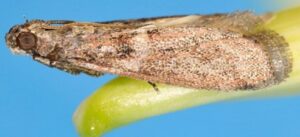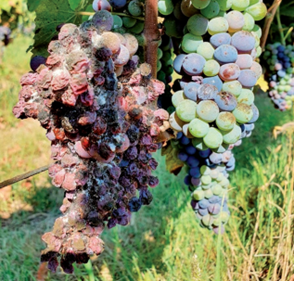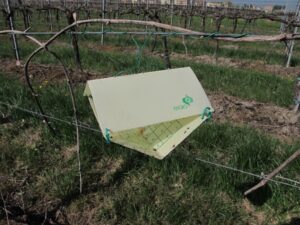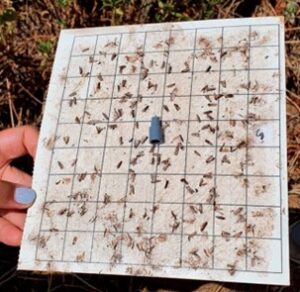
Adulto di C. Gnidiella
The presence of the vine and citrus moth Cryptoblabes gnidiella has been confirmed in Italy for many years, but only recently has its presence increased dangerously, especially in vineyards, to the point that it has become the key pest in some coastal areas, including within a radius of about 30 kilometres from the coast. The Italian regions most affected are Tuscany and Puglia, with significant reports also in Abruzzo, Calabria, Campania, Lazio, Sardinia and Sicily.
HARMFULNESS:

Damage to the bunches
The most significant damage caused by this moth occurs from the second half of July to the beginning of August, which, depending on the variety of vine, corresponds to the phenological stages of bunch closure and the beginning of veraison.
What are the recognisable signs of damage?
- Larval stage: they eat the green tissues of the bunch, such as the rachis, peduncle and pedicel, and a progressive withering of the berries can be observed. They also produce a large amount of silk covered with excrement.
- At an advanced stage of the attack, the whole bunch becomes shriveled.
- Humidity can favour the appearance of certain fungi and acid rot (e.g. Botrytis cinerea).
FACTORS AFFECTING THE SIZE OF THE C. GNIDIELLA POPULATION
- Temperature: temperatures ranging from 25°C to 30°C are optimal for emergence.
- Humidity: relative humidity above 60%;
- Grape variety: late-ripening grape varieties that are harvested in late September and mid-October are the most susceptible.
- Very large and compact bunches: these are an aggravating factor as they create a microhabitat that is extremely favourable to the insect.
Examples of varieties susceptible for these reasons are Aglianico in Puglia and Sangiovese in Tuscany.
THE IMPORTANCE OF MONITORING
The difficulties still encountered are related to the identification of larvae and eggs found inside the bunches. Monitoring with sex pheromone traps is of fundamental importance:
- to identify the curves and the start of flights (which vary annually);
- to estimate the density of the insect population present in the vineyard (in areas where its presence has been confirmed);
- because C. gnidiella is expanding rapidly, “invading” new territories (neighbouring areas) every year;
- to develop a correct and specific defence strategy.
MONITORAGGIO CON TRAPPOLA TRAPTEST® ONE

Traptest one installed in vineyard
To monitor C. gnidiella, we recommend using Traptest® ONE traps baited with the specific pheromone dispenser. We recommend replacing the dispenser every three weeks.
TRAPTEST® ONE consists of a roof and a glued base, joined together by crossed axes; the pheromone dispenser should be placed in the centre of the glued base, where male individuals, attracted by the sex pheromone, will be captured.
The traps must:
- be positioned from May onwards, before the adults begin to fly;
- be checked periodically (weekly);
- three traps must be installed per hectare of vineyard.
INTEGRATION WITH DEFENCE METHODS

Captures of adults
If the presence of adult Cryptoblabes gnidiella is confirmed, specific insecticide treatments must be carried out, always taking into account those already planned for other phytophagous insects (primarily Lobesia botrana).
The methods currently used are:
- treatment with insecticides: both chemical and biological, e.g. Bacillus thuringiensis;
- sexual confusion method: still in the experimental phase.
It is important to be aware of certain agronomic practices that can be useful for prevention:
- creating a microclimate that is unfavourable to the insect;
- removing grape residues from the vineyard after harvesting;
- monitoring the proximity of abandoned vineyards, which may be places where the insect lives and reproduces before moving to neighbouring vineyards.
For further details on TRAPTEST® ONE, click here.
Alternatively, contact us by telephone on Tel: +39 02 3351 4890 or by email at customer.agro@geaitaly.it

